Marketing Leadership: Key Considerations and Objectives for Marketing Practitioners
VerifiedAdded on 2023/06/08
|10
|4344
|174
AI Summary
This report discusses the key considerations that a marketing practitioner needs to take while preparing a marketing audit and the objectives of marketing practitioners. It covers topics such as customer involvement, market conditions, financial objectives, strategic objectives, and communication objectives.
Contribute Materials
Your contribution can guide someone’s learning journey. Share your
documents today.

Running head: MANAGING LEADERSHIP
Marketing leadership
Name of Student: NISH KUNWAR
STUDENT NUMBER: 10454479
Name of College:
Authors Note:
NAME: NISH KUNWAR STUDENT NUMBER 10454479 Page 1
Marketing leadership
Name of Student: NISH KUNWAR
STUDENT NUMBER: 10454479
Name of College:
Authors Note:
NAME: NISH KUNWAR STUDENT NUMBER 10454479 Page 1
Secure Best Marks with AI Grader
Need help grading? Try our AI Grader for instant feedback on your assignments.
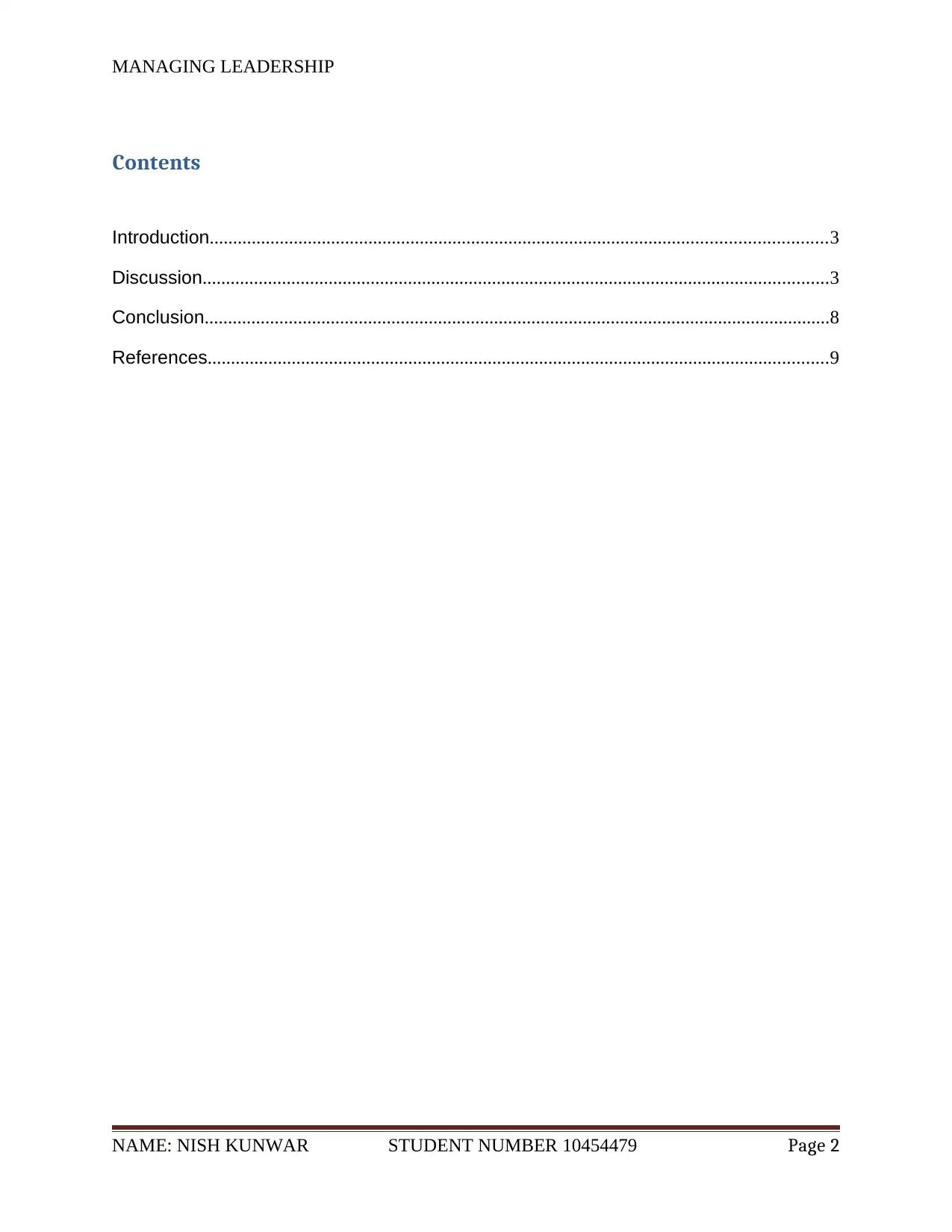
MANAGING LEADERSHIP
Contents
Introduction....................................................................................................................................3
Discussion......................................................................................................................................3
Conclusion......................................................................................................................................8
References.....................................................................................................................................9
NAME: NISH KUNWAR STUDENT NUMBER 10454479 Page 2
Contents
Introduction....................................................................................................................................3
Discussion......................................................................................................................................3
Conclusion......................................................................................................................................8
References.....................................................................................................................................9
NAME: NISH KUNWAR STUDENT NUMBER 10454479 Page 2
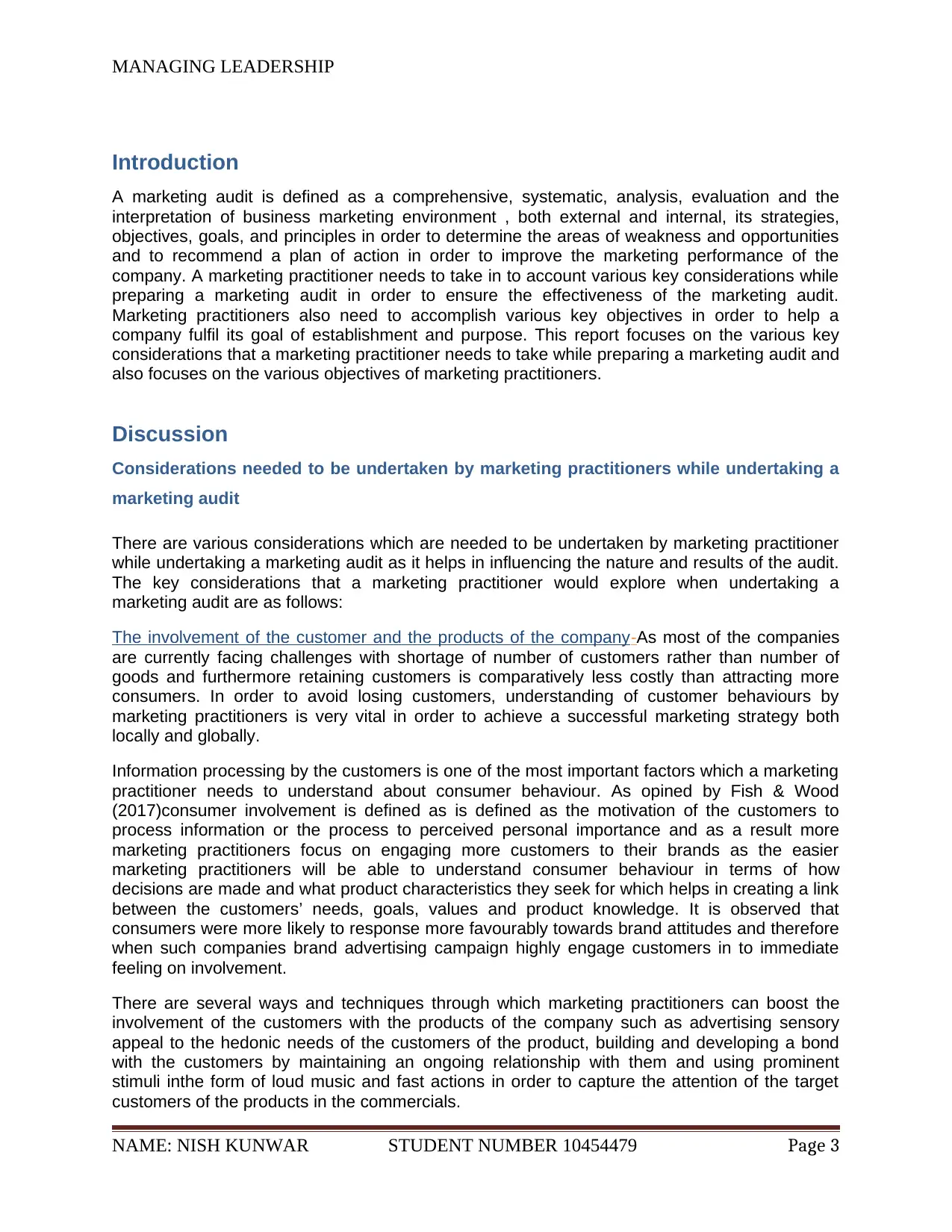
MANAGING LEADERSHIP
Introduction
A marketing audit is defined as a comprehensive, systematic, analysis, evaluation and the
interpretation of business marketing environment , both external and internal, its strategies,
objectives, goals, and principles in order to determine the areas of weakness and opportunities
and to recommend a plan of action in order to improve the marketing performance of the
company. A marketing practitioner needs to take in to account various key considerations while
preparing a marketing audit in order to ensure the effectiveness of the marketing audit.
Marketing practitioners also need to accomplish various key objectives in order to help a
company fulfil its goal of establishment and purpose. This report focuses on the various key
considerations that a marketing practitioner needs to take while preparing a marketing audit and
also focuses on the various objectives of marketing practitioners.
Discussion
Considerations needed to be undertaken by marketing practitioners while undertaking a
marketing audit
There are various considerations which are needed to be undertaken by marketing practitioner
while undertaking a marketing audit as it helps in influencing the nature and results of the audit.
The key considerations that a marketing practitioner would explore when undertaking a
marketing audit are as follows:
The involvement of the customer and the products of the company-As most of the companies
are currently facing challenges with shortage of number of customers rather than number of
goods and furthermore retaining customers is comparatively less costly than attracting more
consumers. In order to avoid losing customers, understanding of customer behaviours by
marketing practitioners is very vital in order to achieve a successful marketing strategy both
locally and globally.
Information processing by the customers is one of the most important factors which a marketing
practitioner needs to understand about consumer behaviour. As opined by Fish & Wood
(2017)consumer involvement is defined as is defined as the motivation of the customers to
process information or the process to perceived personal importance and as a result more
marketing practitioners focus on engaging more customers to their brands as the easier
marketing practitioners will be able to understand consumer behaviour in terms of how
decisions are made and what product characteristics they seek for which helps in creating a link
between the customers’ needs, goals, values and product knowledge. It is observed that
consumers were more likely to response more favourably towards brand attitudes and therefore
when such companies brand advertising campaign highly engage customers in to immediate
feeling on involvement.
There are several ways and techniques through which marketing practitioners can boost the
involvement of the customers with the products of the company such as advertising sensory
appeal to the hedonic needs of the customers of the product, building and developing a bond
with the customers by maintaining an ongoing relationship with them and using prominent
stimuli inthe form of loud music and fast actions in order to capture the attention of the target
customers of the products in the commercials.
NAME: NISH KUNWAR STUDENT NUMBER 10454479 Page 3
Introduction
A marketing audit is defined as a comprehensive, systematic, analysis, evaluation and the
interpretation of business marketing environment , both external and internal, its strategies,
objectives, goals, and principles in order to determine the areas of weakness and opportunities
and to recommend a plan of action in order to improve the marketing performance of the
company. A marketing practitioner needs to take in to account various key considerations while
preparing a marketing audit in order to ensure the effectiveness of the marketing audit.
Marketing practitioners also need to accomplish various key objectives in order to help a
company fulfil its goal of establishment and purpose. This report focuses on the various key
considerations that a marketing practitioner needs to take while preparing a marketing audit and
also focuses on the various objectives of marketing practitioners.
Discussion
Considerations needed to be undertaken by marketing practitioners while undertaking a
marketing audit
There are various considerations which are needed to be undertaken by marketing practitioner
while undertaking a marketing audit as it helps in influencing the nature and results of the audit.
The key considerations that a marketing practitioner would explore when undertaking a
marketing audit are as follows:
The involvement of the customer and the products of the company-As most of the companies
are currently facing challenges with shortage of number of customers rather than number of
goods and furthermore retaining customers is comparatively less costly than attracting more
consumers. In order to avoid losing customers, understanding of customer behaviours by
marketing practitioners is very vital in order to achieve a successful marketing strategy both
locally and globally.
Information processing by the customers is one of the most important factors which a marketing
practitioner needs to understand about consumer behaviour. As opined by Fish & Wood
(2017)consumer involvement is defined as is defined as the motivation of the customers to
process information or the process to perceived personal importance and as a result more
marketing practitioners focus on engaging more customers to their brands as the easier
marketing practitioners will be able to understand consumer behaviour in terms of how
decisions are made and what product characteristics they seek for which helps in creating a link
between the customers’ needs, goals, values and product knowledge. It is observed that
consumers were more likely to response more favourably towards brand attitudes and therefore
when such companies brand advertising campaign highly engage customers in to immediate
feeling on involvement.
There are several ways and techniques through which marketing practitioners can boost the
involvement of the customers with the products of the company such as advertising sensory
appeal to the hedonic needs of the customers of the product, building and developing a bond
with the customers by maintaining an ongoing relationship with them and using prominent
stimuli inthe form of loud music and fast actions in order to capture the attention of the target
customers of the products in the commercials.
NAME: NISH KUNWAR STUDENT NUMBER 10454479 Page 3
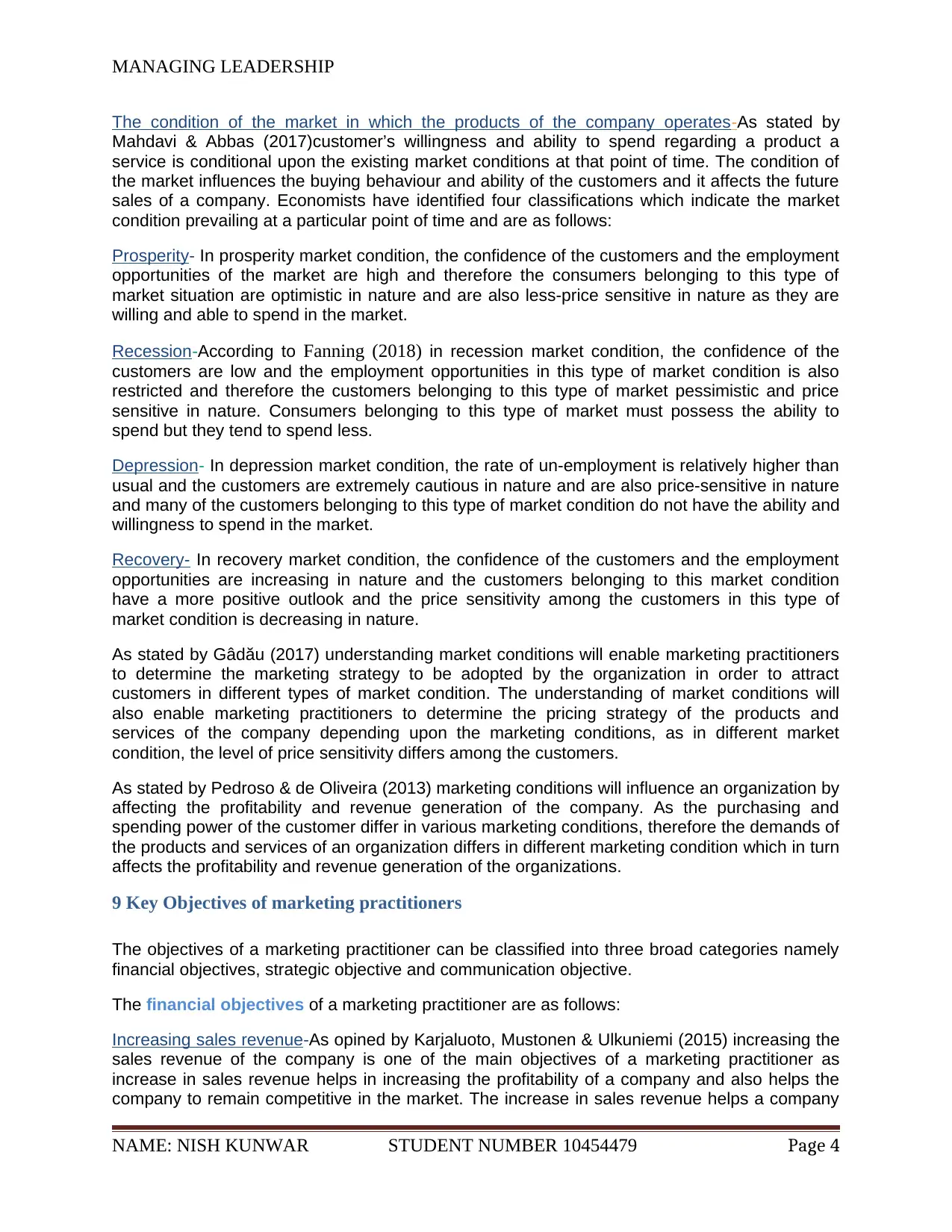
MANAGING LEADERSHIP
The condition of the market in which the products of the company operates-As stated by
Mahdavi & Abbas (2017)customer’s willingness and ability to spend regarding a product a
service is conditional upon the existing market conditions at that point of time. The condition of
the market influences the buying behaviour and ability of the customers and it affects the future
sales of a company. Economists have identified four classifications which indicate the market
condition prevailing at a particular point of time and are as follows:
Prosperity- In prosperity market condition, the confidence of the customers and the employment
opportunities of the market are high and therefore the consumers belonging to this type of
market situation are optimistic in nature and are also less-price sensitive in nature as they are
willing and able to spend in the market.
Recession-According to Fanning (2018) in recession market condition, the confidence of the
customers are low and the employment opportunities in this type of market condition is also
restricted and therefore the customers belonging to this type of market pessimistic and price
sensitive in nature. Consumers belonging to this type of market must possess the ability to
spend but they tend to spend less.
Depression- In depression market condition, the rate of un-employment is relatively higher than
usual and the customers are extremely cautious in nature and are also price-sensitive in nature
and many of the customers belonging to this type of market condition do not have the ability and
willingness to spend in the market.
Recovery- In recovery market condition, the confidence of the customers and the employment
opportunities are increasing in nature and the customers belonging to this market condition
have a more positive outlook and the price sensitivity among the customers in this type of
market condition is decreasing in nature.
As stated by Gâdău (2017) understanding market conditions will enable marketing practitioners
to determine the marketing strategy to be adopted by the organization in order to attract
customers in different types of market condition. The understanding of market conditions will
also enable marketing practitioners to determine the pricing strategy of the products and
services of the company depending upon the marketing conditions, as in different market
condition, the level of price sensitivity differs among the customers.
As stated by Pedroso & de Oliveira (2013) marketing conditions will influence an organization by
affecting the profitability and revenue generation of the company. As the purchasing and
spending power of the customer differ in various marketing conditions, therefore the demands of
the products and services of an organization differs in different marketing condition which in turn
affects the profitability and revenue generation of the organizations.
9 Key Objectives of marketing practitioners
The objectives of a marketing practitioner can be classified into three broad categories namely
financial objectives, strategic objective and communication objective.
The financial objectives of a marketing practitioner are as follows:
Increasing sales revenue-As opined by Karjaluoto, Mustonen & Ulkuniemi (2015) increasing the
sales revenue of the company is one of the main objectives of a marketing practitioner as
increase in sales revenue helps in increasing the profitability of a company and also helps the
company to remain competitive in the market. The increase in sales revenue helps a company
NAME: NISH KUNWAR STUDENT NUMBER 10454479 Page 4
The condition of the market in which the products of the company operates-As stated by
Mahdavi & Abbas (2017)customer’s willingness and ability to spend regarding a product a
service is conditional upon the existing market conditions at that point of time. The condition of
the market influences the buying behaviour and ability of the customers and it affects the future
sales of a company. Economists have identified four classifications which indicate the market
condition prevailing at a particular point of time and are as follows:
Prosperity- In prosperity market condition, the confidence of the customers and the employment
opportunities of the market are high and therefore the consumers belonging to this type of
market situation are optimistic in nature and are also less-price sensitive in nature as they are
willing and able to spend in the market.
Recession-According to Fanning (2018) in recession market condition, the confidence of the
customers are low and the employment opportunities in this type of market condition is also
restricted and therefore the customers belonging to this type of market pessimistic and price
sensitive in nature. Consumers belonging to this type of market must possess the ability to
spend but they tend to spend less.
Depression- In depression market condition, the rate of un-employment is relatively higher than
usual and the customers are extremely cautious in nature and are also price-sensitive in nature
and many of the customers belonging to this type of market condition do not have the ability and
willingness to spend in the market.
Recovery- In recovery market condition, the confidence of the customers and the employment
opportunities are increasing in nature and the customers belonging to this market condition
have a more positive outlook and the price sensitivity among the customers in this type of
market condition is decreasing in nature.
As stated by Gâdău (2017) understanding market conditions will enable marketing practitioners
to determine the marketing strategy to be adopted by the organization in order to attract
customers in different types of market condition. The understanding of market conditions will
also enable marketing practitioners to determine the pricing strategy of the products and
services of the company depending upon the marketing conditions, as in different market
condition, the level of price sensitivity differs among the customers.
As stated by Pedroso & de Oliveira (2013) marketing conditions will influence an organization by
affecting the profitability and revenue generation of the company. As the purchasing and
spending power of the customer differ in various marketing conditions, therefore the demands of
the products and services of an organization differs in different marketing condition which in turn
affects the profitability and revenue generation of the organizations.
9 Key Objectives of marketing practitioners
The objectives of a marketing practitioner can be classified into three broad categories namely
financial objectives, strategic objective and communication objective.
The financial objectives of a marketing practitioner are as follows:
Increasing sales revenue-As opined by Karjaluoto, Mustonen & Ulkuniemi (2015) increasing the
sales revenue of the company is one of the main objectives of a marketing practitioner as
increase in sales revenue helps in increasing the profitability of a company and also helps the
company to remain competitive in the market. The increase in sales revenue helps a company
NAME: NISH KUNWAR STUDENT NUMBER 10454479 Page 4
Secure Best Marks with AI Grader
Need help grading? Try our AI Grader for instant feedback on your assignments.
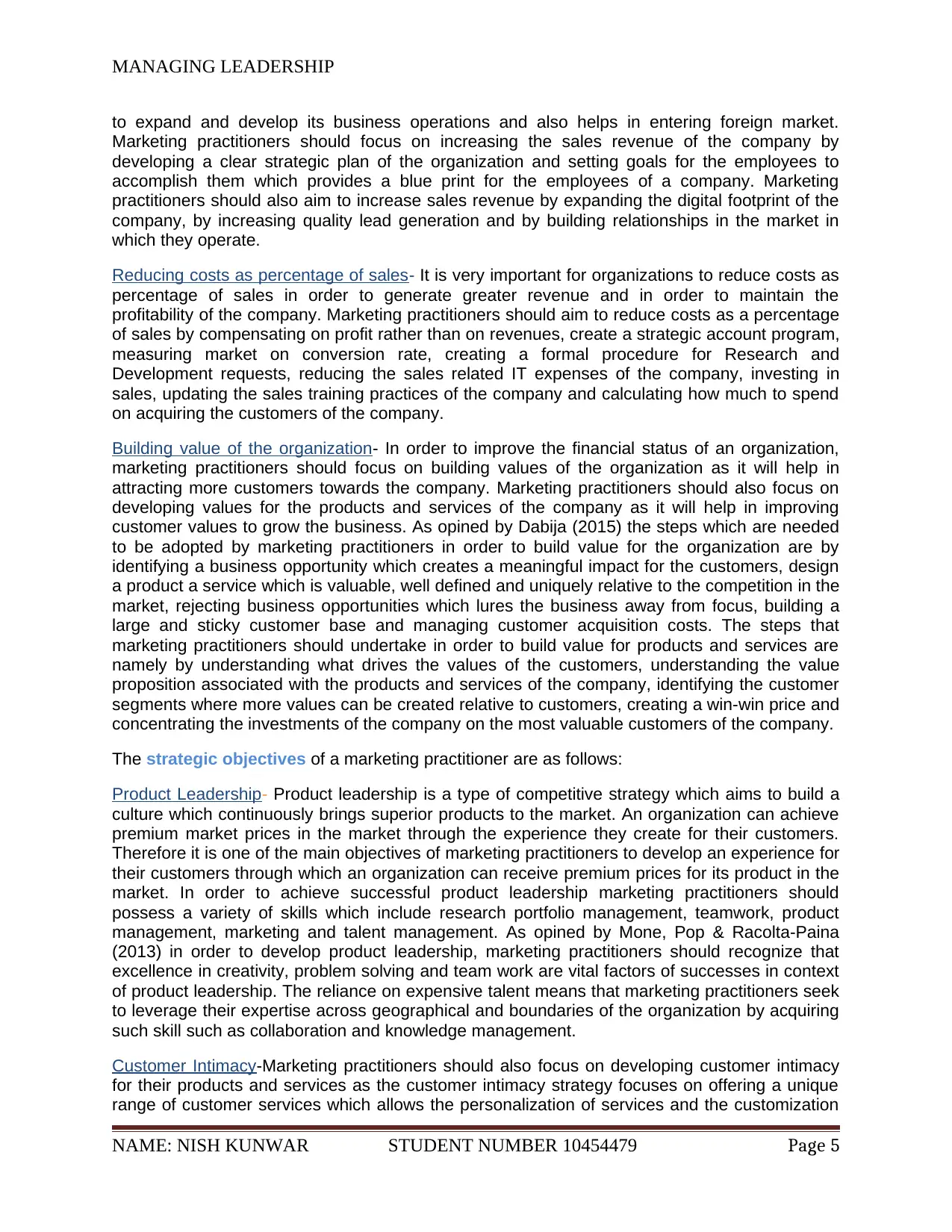
MANAGING LEADERSHIP
to expand and develop its business operations and also helps in entering foreign market.
Marketing practitioners should focus on increasing the sales revenue of the company by
developing a clear strategic plan of the organization and setting goals for the employees to
accomplish them which provides a blue print for the employees of a company. Marketing
practitioners should also aim to increase sales revenue by expanding the digital footprint of the
company, by increasing quality lead generation and by building relationships in the market in
which they operate.
Reducing costs as percentage of sales- It is very important for organizations to reduce costs as
percentage of sales in order to generate greater revenue and in order to maintain the
profitability of the company. Marketing practitioners should aim to reduce costs as a percentage
of sales by compensating on profit rather than on revenues, create a strategic account program,
measuring market on conversion rate, creating a formal procedure for Research and
Development requests, reducing the sales related IT expenses of the company, investing in
sales, updating the sales training practices of the company and calculating how much to spend
on acquiring the customers of the company.
Building value of the organization- In order to improve the financial status of an organization,
marketing practitioners should focus on building values of the organization as it will help in
attracting more customers towards the company. Marketing practitioners should also focus on
developing values for the products and services of the company as it will help in improving
customer values to grow the business. As opined by Dabija (2015) the steps which are needed
to be adopted by marketing practitioners in order to build value for the organization are by
identifying a business opportunity which creates a meaningful impact for the customers, design
a product a service which is valuable, well defined and uniquely relative to the competition in the
market, rejecting business opportunities which lures the business away from focus, building a
large and sticky customer base and managing customer acquisition costs. The steps that
marketing practitioners should undertake in order to build value for products and services are
namely by understanding what drives the values of the customers, understanding the value
proposition associated with the products and services of the company, identifying the customer
segments where more values can be created relative to customers, creating a win-win price and
concentrating the investments of the company on the most valuable customers of the company.
The strategic objectives of a marketing practitioner are as follows:
Product Leadership- Product leadership is a type of competitive strategy which aims to build a
culture which continuously brings superior products to the market. An organization can achieve
premium market prices in the market through the experience they create for their customers.
Therefore it is one of the main objectives of marketing practitioners to develop an experience for
their customers through which an organization can receive premium prices for its product in the
market. In order to achieve successful product leadership marketing practitioners should
possess a variety of skills which include research portfolio management, teamwork, product
management, marketing and talent management. As opined by Mone, Pop & Racolta-Paina
(2013) in order to develop product leadership, marketing practitioners should recognize that
excellence in creativity, problem solving and team work are vital factors of successes in context
of product leadership. The reliance on expensive talent means that marketing practitioners seek
to leverage their expertise across geographical and boundaries of the organization by acquiring
such skill such as collaboration and knowledge management.
Customer Intimacy-Marketing practitioners should also focus on developing customer intimacy
for their products and services as the customer intimacy strategy focuses on offering a unique
range of customer services which allows the personalization of services and the customization
NAME: NISH KUNWAR STUDENT NUMBER 10454479 Page 5
to expand and develop its business operations and also helps in entering foreign market.
Marketing practitioners should focus on increasing the sales revenue of the company by
developing a clear strategic plan of the organization and setting goals for the employees to
accomplish them which provides a blue print for the employees of a company. Marketing
practitioners should also aim to increase sales revenue by expanding the digital footprint of the
company, by increasing quality lead generation and by building relationships in the market in
which they operate.
Reducing costs as percentage of sales- It is very important for organizations to reduce costs as
percentage of sales in order to generate greater revenue and in order to maintain the
profitability of the company. Marketing practitioners should aim to reduce costs as a percentage
of sales by compensating on profit rather than on revenues, create a strategic account program,
measuring market on conversion rate, creating a formal procedure for Research and
Development requests, reducing the sales related IT expenses of the company, investing in
sales, updating the sales training practices of the company and calculating how much to spend
on acquiring the customers of the company.
Building value of the organization- In order to improve the financial status of an organization,
marketing practitioners should focus on building values of the organization as it will help in
attracting more customers towards the company. Marketing practitioners should also focus on
developing values for the products and services of the company as it will help in improving
customer values to grow the business. As opined by Dabija (2015) the steps which are needed
to be adopted by marketing practitioners in order to build value for the organization are by
identifying a business opportunity which creates a meaningful impact for the customers, design
a product a service which is valuable, well defined and uniquely relative to the competition in the
market, rejecting business opportunities which lures the business away from focus, building a
large and sticky customer base and managing customer acquisition costs. The steps that
marketing practitioners should undertake in order to build value for products and services are
namely by understanding what drives the values of the customers, understanding the value
proposition associated with the products and services of the company, identifying the customer
segments where more values can be created relative to customers, creating a win-win price and
concentrating the investments of the company on the most valuable customers of the company.
The strategic objectives of a marketing practitioner are as follows:
Product Leadership- Product leadership is a type of competitive strategy which aims to build a
culture which continuously brings superior products to the market. An organization can achieve
premium market prices in the market through the experience they create for their customers.
Therefore it is one of the main objectives of marketing practitioners to develop an experience for
their customers through which an organization can receive premium prices for its product in the
market. In order to achieve successful product leadership marketing practitioners should
possess a variety of skills which include research portfolio management, teamwork, product
management, marketing and talent management. As opined by Mone, Pop & Racolta-Paina
(2013) in order to develop product leadership, marketing practitioners should recognize that
excellence in creativity, problem solving and team work are vital factors of successes in context
of product leadership. The reliance on expensive talent means that marketing practitioners seek
to leverage their expertise across geographical and boundaries of the organization by acquiring
such skill such as collaboration and knowledge management.
Customer Intimacy-Marketing practitioners should also focus on developing customer intimacy
for their products and services as the customer intimacy strategy focuses on offering a unique
range of customer services which allows the personalization of services and the customization
NAME: NISH KUNWAR STUDENT NUMBER 10454479 Page 5
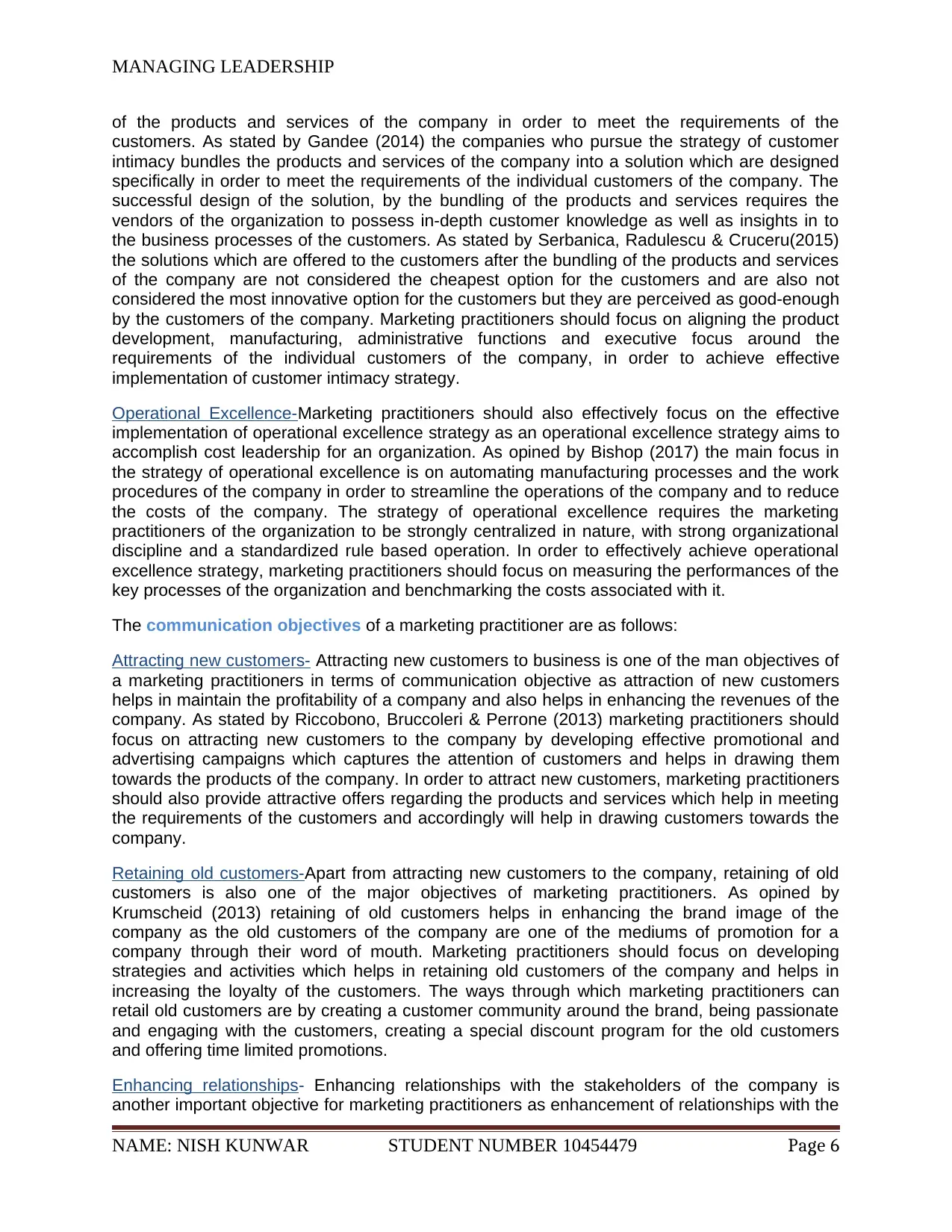
MANAGING LEADERSHIP
of the products and services of the company in order to meet the requirements of the
customers. As stated by Gandee (2014) the companies who pursue the strategy of customer
intimacy bundles the products and services of the company into a solution which are designed
specifically in order to meet the requirements of the individual customers of the company. The
successful design of the solution, by the bundling of the products and services requires the
vendors of the organization to possess in-depth customer knowledge as well as insights in to
the business processes of the customers. As stated by Serbanica, Radulescu & Cruceru(2015)
the solutions which are offered to the customers after the bundling of the products and services
of the company are not considered the cheapest option for the customers and are also not
considered the most innovative option for the customers but they are perceived as good-enough
by the customers of the company. Marketing practitioners should focus on aligning the product
development, manufacturing, administrative functions and executive focus around the
requirements of the individual customers of the company, in order to achieve effective
implementation of customer intimacy strategy.
Operational Excellence-Marketing practitioners should also effectively focus on the effective
implementation of operational excellence strategy as an operational excellence strategy aims to
accomplish cost leadership for an organization. As opined by Bishop (2017) the main focus in
the strategy of operational excellence is on automating manufacturing processes and the work
procedures of the company in order to streamline the operations of the company and to reduce
the costs of the company. The strategy of operational excellence requires the marketing
practitioners of the organization to be strongly centralized in nature, with strong organizational
discipline and a standardized rule based operation. In order to effectively achieve operational
excellence strategy, marketing practitioners should focus on measuring the performances of the
key processes of the organization and benchmarking the costs associated with it.
The communication objectives of a marketing practitioner are as follows:
Attracting new customers- Attracting new customers to business is one of the man objectives of
a marketing practitioners in terms of communication objective as attraction of new customers
helps in maintain the profitability of a company and also helps in enhancing the revenues of the
company. As stated by Riccobono, Bruccoleri & Perrone (2013) marketing practitioners should
focus on attracting new customers to the company by developing effective promotional and
advertising campaigns which captures the attention of customers and helps in drawing them
towards the products of the company. In order to attract new customers, marketing practitioners
should also provide attractive offers regarding the products and services which help in meeting
the requirements of the customers and accordingly will help in drawing customers towards the
company.
Retaining old customers-Apart from attracting new customers to the company, retaining of old
customers is also one of the major objectives of marketing practitioners. As opined by
Krumscheid (2013) retaining of old customers helps in enhancing the brand image of the
company as the old customers of the company are one of the mediums of promotion for a
company through their word of mouth. Marketing practitioners should focus on developing
strategies and activities which helps in retaining old customers of the company and helps in
increasing the loyalty of the customers. The ways through which marketing practitioners can
retail old customers are by creating a customer community around the brand, being passionate
and engaging with the customers, creating a special discount program for the old customers
and offering time limited promotions.
Enhancing relationships- Enhancing relationships with the stakeholders of the company is
another important objective for marketing practitioners as enhancement of relationships with the
NAME: NISH KUNWAR STUDENT NUMBER 10454479 Page 6
of the products and services of the company in order to meet the requirements of the
customers. As stated by Gandee (2014) the companies who pursue the strategy of customer
intimacy bundles the products and services of the company into a solution which are designed
specifically in order to meet the requirements of the individual customers of the company. The
successful design of the solution, by the bundling of the products and services requires the
vendors of the organization to possess in-depth customer knowledge as well as insights in to
the business processes of the customers. As stated by Serbanica, Radulescu & Cruceru(2015)
the solutions which are offered to the customers after the bundling of the products and services
of the company are not considered the cheapest option for the customers and are also not
considered the most innovative option for the customers but they are perceived as good-enough
by the customers of the company. Marketing practitioners should focus on aligning the product
development, manufacturing, administrative functions and executive focus around the
requirements of the individual customers of the company, in order to achieve effective
implementation of customer intimacy strategy.
Operational Excellence-Marketing practitioners should also effectively focus on the effective
implementation of operational excellence strategy as an operational excellence strategy aims to
accomplish cost leadership for an organization. As opined by Bishop (2017) the main focus in
the strategy of operational excellence is on automating manufacturing processes and the work
procedures of the company in order to streamline the operations of the company and to reduce
the costs of the company. The strategy of operational excellence requires the marketing
practitioners of the organization to be strongly centralized in nature, with strong organizational
discipline and a standardized rule based operation. In order to effectively achieve operational
excellence strategy, marketing practitioners should focus on measuring the performances of the
key processes of the organization and benchmarking the costs associated with it.
The communication objectives of a marketing practitioner are as follows:
Attracting new customers- Attracting new customers to business is one of the man objectives of
a marketing practitioners in terms of communication objective as attraction of new customers
helps in maintain the profitability of a company and also helps in enhancing the revenues of the
company. As stated by Riccobono, Bruccoleri & Perrone (2013) marketing practitioners should
focus on attracting new customers to the company by developing effective promotional and
advertising campaigns which captures the attention of customers and helps in drawing them
towards the products of the company. In order to attract new customers, marketing practitioners
should also provide attractive offers regarding the products and services which help in meeting
the requirements of the customers and accordingly will help in drawing customers towards the
company.
Retaining old customers-Apart from attracting new customers to the company, retaining of old
customers is also one of the major objectives of marketing practitioners. As opined by
Krumscheid (2013) retaining of old customers helps in enhancing the brand image of the
company as the old customers of the company are one of the mediums of promotion for a
company through their word of mouth. Marketing practitioners should focus on developing
strategies and activities which helps in retaining old customers of the company and helps in
increasing the loyalty of the customers. The ways through which marketing practitioners can
retail old customers are by creating a customer community around the brand, being passionate
and engaging with the customers, creating a special discount program for the old customers
and offering time limited promotions.
Enhancing relationships- Enhancing relationships with the stakeholders of the company is
another important objective for marketing practitioners as enhancement of relationships with the
NAME: NISH KUNWAR STUDENT NUMBER 10454479 Page 6
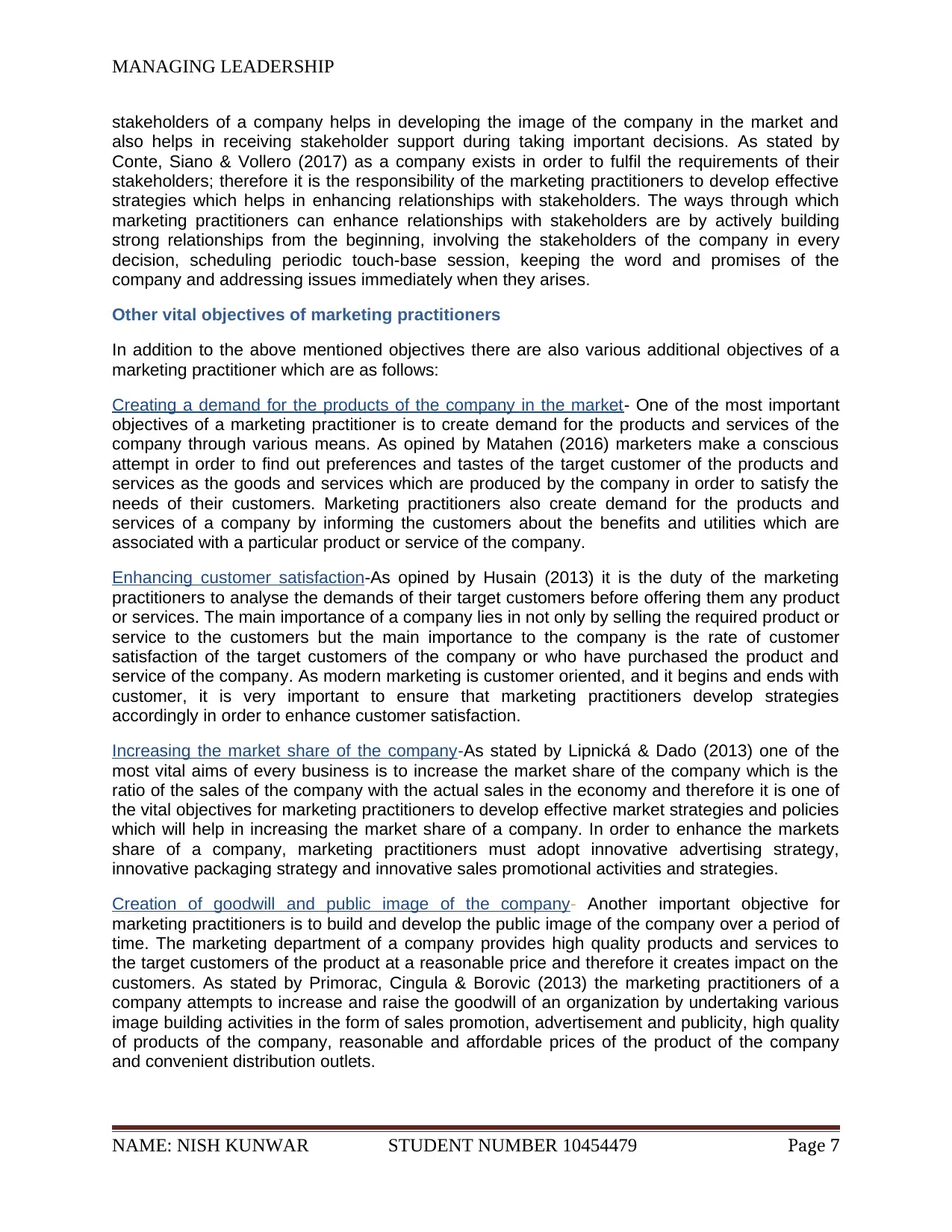
MANAGING LEADERSHIP
stakeholders of a company helps in developing the image of the company in the market and
also helps in receiving stakeholder support during taking important decisions. As stated by
Conte, Siano & Vollero (2017) as a company exists in order to fulfil the requirements of their
stakeholders; therefore it is the responsibility of the marketing practitioners to develop effective
strategies which helps in enhancing relationships with stakeholders. The ways through which
marketing practitioners can enhance relationships with stakeholders are by actively building
strong relationships from the beginning, involving the stakeholders of the company in every
decision, scheduling periodic touch-base session, keeping the word and promises of the
company and addressing issues immediately when they arises.
Other vital objectives of marketing practitioners
In addition to the above mentioned objectives there are also various additional objectives of a
marketing practitioner which are as follows:
Creating a demand for the products of the company in the market- One of the most important
objectives of a marketing practitioner is to create demand for the products and services of the
company through various means. As opined by Matahen (2016) marketers make a conscious
attempt in order to find out preferences and tastes of the target customer of the products and
services as the goods and services which are produced by the company in order to satisfy the
needs of their customers. Marketing practitioners also create demand for the products and
services of a company by informing the customers about the benefits and utilities which are
associated with a particular product or service of the company.
Enhancing customer satisfaction-As opined by Husain (2013) it is the duty of the marketing
practitioners to analyse the demands of their target customers before offering them any product
or services. The main importance of a company lies in not only by selling the required product or
service to the customers but the main importance to the company is the rate of customer
satisfaction of the target customers of the company or who have purchased the product and
service of the company. As modern marketing is customer oriented, and it begins and ends with
customer, it is very important to ensure that marketing practitioners develop strategies
accordingly in order to enhance customer satisfaction.
Increasing the market share of the company-As stated by Lipnická & Dado (2013) one of the
most vital aims of every business is to increase the market share of the company which is the
ratio of the sales of the company with the actual sales in the economy and therefore it is one of
the vital objectives for marketing practitioners to develop effective market strategies and policies
which will help in increasing the market share of a company. In order to enhance the markets
share of a company, marketing practitioners must adopt innovative advertising strategy,
innovative packaging strategy and innovative sales promotional activities and strategies.
Creation of goodwill and public image of the company- Another important objective for
marketing practitioners is to build and develop the public image of the company over a period of
time. The marketing department of a company provides high quality products and services to
the target customers of the product at a reasonable price and therefore it creates impact on the
customers. As stated by Primorac, Cingula & Borovic (2013) the marketing practitioners of a
company attempts to increase and raise the goodwill of an organization by undertaking various
image building activities in the form of sales promotion, advertisement and publicity, high quality
of products of the company, reasonable and affordable prices of the product of the company
and convenient distribution outlets.
NAME: NISH KUNWAR STUDENT NUMBER 10454479 Page 7
stakeholders of a company helps in developing the image of the company in the market and
also helps in receiving stakeholder support during taking important decisions. As stated by
Conte, Siano & Vollero (2017) as a company exists in order to fulfil the requirements of their
stakeholders; therefore it is the responsibility of the marketing practitioners to develop effective
strategies which helps in enhancing relationships with stakeholders. The ways through which
marketing practitioners can enhance relationships with stakeholders are by actively building
strong relationships from the beginning, involving the stakeholders of the company in every
decision, scheduling periodic touch-base session, keeping the word and promises of the
company and addressing issues immediately when they arises.
Other vital objectives of marketing practitioners
In addition to the above mentioned objectives there are also various additional objectives of a
marketing practitioner which are as follows:
Creating a demand for the products of the company in the market- One of the most important
objectives of a marketing practitioner is to create demand for the products and services of the
company through various means. As opined by Matahen (2016) marketers make a conscious
attempt in order to find out preferences and tastes of the target customer of the products and
services as the goods and services which are produced by the company in order to satisfy the
needs of their customers. Marketing practitioners also create demand for the products and
services of a company by informing the customers about the benefits and utilities which are
associated with a particular product or service of the company.
Enhancing customer satisfaction-As opined by Husain (2013) it is the duty of the marketing
practitioners to analyse the demands of their target customers before offering them any product
or services. The main importance of a company lies in not only by selling the required product or
service to the customers but the main importance to the company is the rate of customer
satisfaction of the target customers of the company or who have purchased the product and
service of the company. As modern marketing is customer oriented, and it begins and ends with
customer, it is very important to ensure that marketing practitioners develop strategies
accordingly in order to enhance customer satisfaction.
Increasing the market share of the company-As stated by Lipnická & Dado (2013) one of the
most vital aims of every business is to increase the market share of the company which is the
ratio of the sales of the company with the actual sales in the economy and therefore it is one of
the vital objectives for marketing practitioners to develop effective market strategies and policies
which will help in increasing the market share of a company. In order to enhance the markets
share of a company, marketing practitioners must adopt innovative advertising strategy,
innovative packaging strategy and innovative sales promotional activities and strategies.
Creation of goodwill and public image of the company- Another important objective for
marketing practitioners is to build and develop the public image of the company over a period of
time. The marketing department of a company provides high quality products and services to
the target customers of the product at a reasonable price and therefore it creates impact on the
customers. As stated by Primorac, Cingula & Borovic (2013) the marketing practitioners of a
company attempts to increase and raise the goodwill of an organization by undertaking various
image building activities in the form of sales promotion, advertisement and publicity, high quality
of products of the company, reasonable and affordable prices of the product of the company
and convenient distribution outlets.
NAME: NISH KUNWAR STUDENT NUMBER 10454479 Page 7
Paraphrase This Document
Need a fresh take? Get an instant paraphrase of this document with our AI Paraphraser
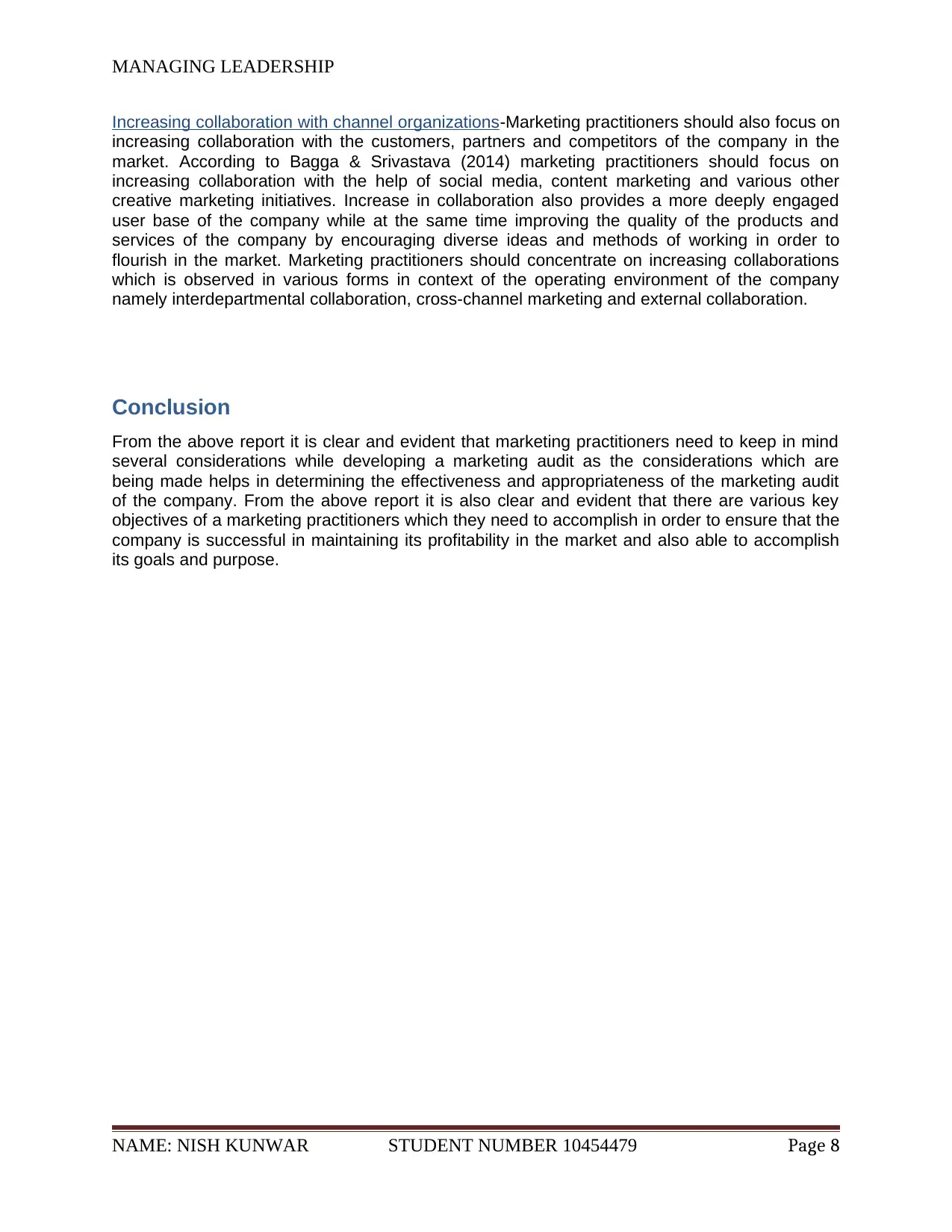
MANAGING LEADERSHIP
Increasing collaboration with channel organizations-Marketing practitioners should also focus on
increasing collaboration with the customers, partners and competitors of the company in the
market. According to Bagga & Srivastava (2014) marketing practitioners should focus on
increasing collaboration with the help of social media, content marketing and various other
creative marketing initiatives. Increase in collaboration also provides a more deeply engaged
user base of the company while at the same time improving the quality of the products and
services of the company by encouraging diverse ideas and methods of working in order to
flourish in the market. Marketing practitioners should concentrate on increasing collaborations
which is observed in various forms in context of the operating environment of the company
namely interdepartmental collaboration, cross-channel marketing and external collaboration.
Conclusion
From the above report it is clear and evident that marketing practitioners need to keep in mind
several considerations while developing a marketing audit as the considerations which are
being made helps in determining the effectiveness and appropriateness of the marketing audit
of the company. From the above report it is also clear and evident that there are various key
objectives of a marketing practitioners which they need to accomplish in order to ensure that the
company is successful in maintaining its profitability in the market and also able to accomplish
its goals and purpose.
NAME: NISH KUNWAR STUDENT NUMBER 10454479 Page 8
Increasing collaboration with channel organizations-Marketing practitioners should also focus on
increasing collaboration with the customers, partners and competitors of the company in the
market. According to Bagga & Srivastava (2014) marketing practitioners should focus on
increasing collaboration with the help of social media, content marketing and various other
creative marketing initiatives. Increase in collaboration also provides a more deeply engaged
user base of the company while at the same time improving the quality of the products and
services of the company by encouraging diverse ideas and methods of working in order to
flourish in the market. Marketing practitioners should concentrate on increasing collaborations
which is observed in various forms in context of the operating environment of the company
namely interdepartmental collaboration, cross-channel marketing and external collaboration.
Conclusion
From the above report it is clear and evident that marketing practitioners need to keep in mind
several considerations while developing a marketing audit as the considerations which are
being made helps in determining the effectiveness and appropriateness of the marketing audit
of the company. From the above report it is also clear and evident that there are various key
objectives of a marketing practitioners which they need to accomplish in order to ensure that the
company is successful in maintaining its profitability in the market and also able to accomplish
its goals and purpose.
NAME: NISH KUNWAR STUDENT NUMBER 10454479 Page 8
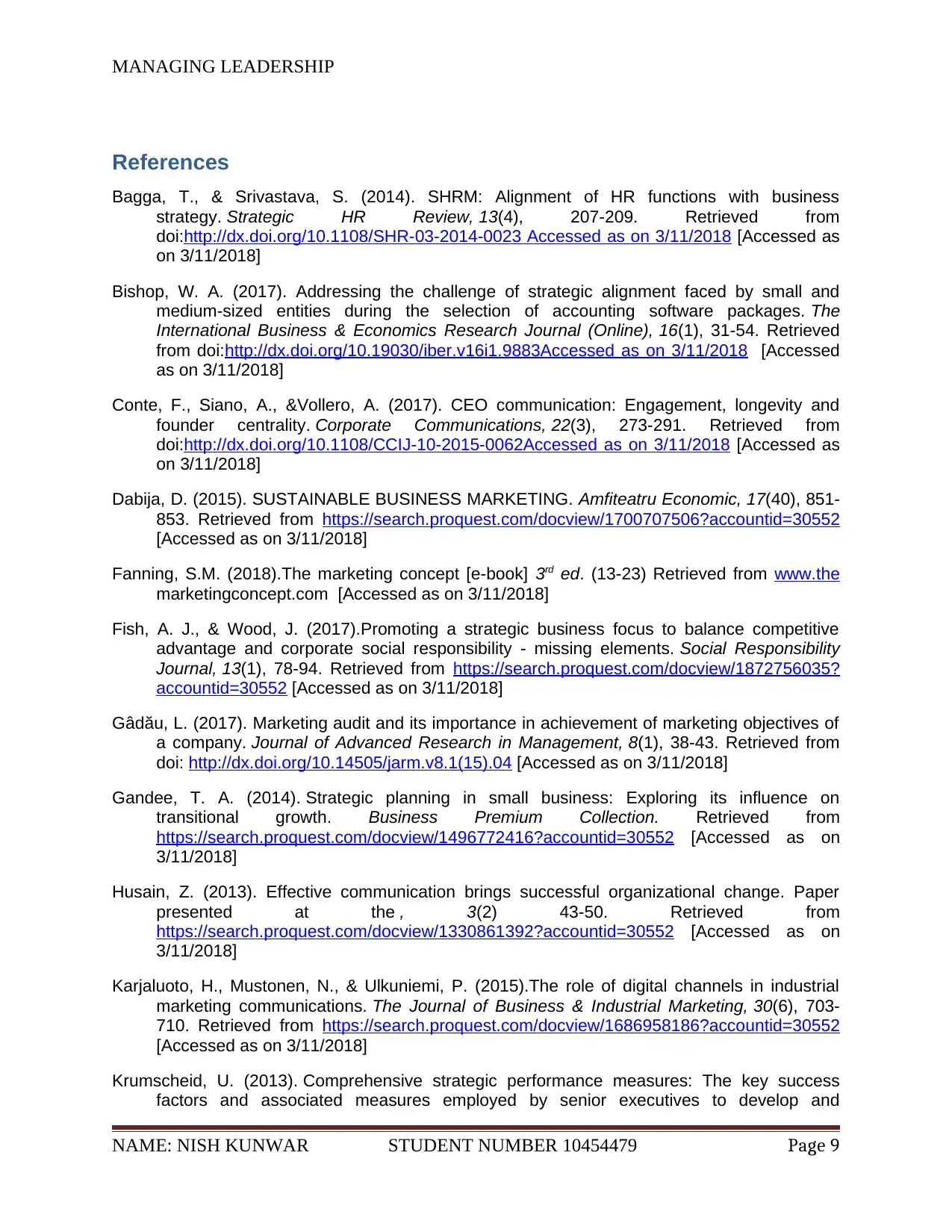
MANAGING LEADERSHIP
References
Bagga, T., & Srivastava, S. (2014). SHRM: Alignment of HR functions with business
strategy. Strategic HR Review, 13(4), 207-209. Retrieved from
doi:http://dx.doi.org/10.1108/SHR-03-2014-0023 Accessed as on 3/11/2018 [Accessed as
on 3/11/2018]
Bishop, W. A. (2017). Addressing the challenge of strategic alignment faced by small and
medium-sized entities during the selection of accounting software packages. The
International Business & Economics Research Journal (Online), 16(1), 31-54. Retrieved
from doi:http://dx.doi.org/10.19030/iber.v16i1.9883Accessed as on 3/11/2018 [Accessed
as on 3/11/2018]
Conte, F., Siano, A., &Vollero, A. (2017). CEO communication: Engagement, longevity and
founder centrality. Corporate Communications, 22(3), 273-291. Retrieved from
doi:http://dx.doi.org/10.1108/CCIJ-10-2015-0062Accessed as on 3/11/2018 [Accessed as
on 3/11/2018]
Dabija, D. (2015). SUSTAINABLE BUSINESS MARKETING. Amfiteatru Economic, 17(40), 851-
853. Retrieved from https://search.proquest.com/docview/1700707506?accountid=30552
[Accessed as on 3/11/2018]
Fanning, S.M. (2018).The marketing concept [e-book] 3rd ed. (13-23) Retrieved from www.the
marketingconcept.com [Accessed as on 3/11/2018]
Fish, A. J., & Wood, J. (2017).Promoting a strategic business focus to balance competitive
advantage and corporate social responsibility - missing elements. Social Responsibility
Journal, 13(1), 78-94. Retrieved from https://search.proquest.com/docview/1872756035?
accountid=30552 [Accessed as on 3/11/2018]
Gâdău, L. (2017). Marketing audit and its importance in achievement of marketing objectives of
a company. Journal of Advanced Research in Management, 8(1), 38-43. Retrieved from
doi: http://dx.doi.org/10.14505/jarm.v8.1(15).04 [Accessed as on 3/11/2018]
Gandee, T. A. (2014). Strategic planning in small business: Exploring its influence on
transitional growth. Business Premium Collection. Retrieved from
https://search.proquest.com/docview/1496772416?accountid=30552 [Accessed as on
3/11/2018]
Husain, Z. (2013). Effective communication brings successful organizational change. Paper
presented at the , 3(2) 43-50. Retrieved from
https://search.proquest.com/docview/1330861392?accountid=30552 [Accessed as on
3/11/2018]
Karjaluoto, H., Mustonen, N., & Ulkuniemi, P. (2015).The role of digital channels in industrial
marketing communications. The Journal of Business & Industrial Marketing, 30(6), 703-
710. Retrieved from https://search.proquest.com/docview/1686958186?accountid=30552
[Accessed as on 3/11/2018]
Krumscheid, U. (2013). Comprehensive strategic performance measures: The key success
factors and associated measures employed by senior executives to develop and
NAME: NISH KUNWAR STUDENT NUMBER 10454479 Page 9
References
Bagga, T., & Srivastava, S. (2014). SHRM: Alignment of HR functions with business
strategy. Strategic HR Review, 13(4), 207-209. Retrieved from
doi:http://dx.doi.org/10.1108/SHR-03-2014-0023 Accessed as on 3/11/2018 [Accessed as
on 3/11/2018]
Bishop, W. A. (2017). Addressing the challenge of strategic alignment faced by small and
medium-sized entities during the selection of accounting software packages. The
International Business & Economics Research Journal (Online), 16(1), 31-54. Retrieved
from doi:http://dx.doi.org/10.19030/iber.v16i1.9883Accessed as on 3/11/2018 [Accessed
as on 3/11/2018]
Conte, F., Siano, A., &Vollero, A. (2017). CEO communication: Engagement, longevity and
founder centrality. Corporate Communications, 22(3), 273-291. Retrieved from
doi:http://dx.doi.org/10.1108/CCIJ-10-2015-0062Accessed as on 3/11/2018 [Accessed as
on 3/11/2018]
Dabija, D. (2015). SUSTAINABLE BUSINESS MARKETING. Amfiteatru Economic, 17(40), 851-
853. Retrieved from https://search.proquest.com/docview/1700707506?accountid=30552
[Accessed as on 3/11/2018]
Fanning, S.M. (2018).The marketing concept [e-book] 3rd ed. (13-23) Retrieved from www.the
marketingconcept.com [Accessed as on 3/11/2018]
Fish, A. J., & Wood, J. (2017).Promoting a strategic business focus to balance competitive
advantage and corporate social responsibility - missing elements. Social Responsibility
Journal, 13(1), 78-94. Retrieved from https://search.proquest.com/docview/1872756035?
accountid=30552 [Accessed as on 3/11/2018]
Gâdău, L. (2017). Marketing audit and its importance in achievement of marketing objectives of
a company. Journal of Advanced Research in Management, 8(1), 38-43. Retrieved from
doi: http://dx.doi.org/10.14505/jarm.v8.1(15).04 [Accessed as on 3/11/2018]
Gandee, T. A. (2014). Strategic planning in small business: Exploring its influence on
transitional growth. Business Premium Collection. Retrieved from
https://search.proquest.com/docview/1496772416?accountid=30552 [Accessed as on
3/11/2018]
Husain, Z. (2013). Effective communication brings successful organizational change. Paper
presented at the , 3(2) 43-50. Retrieved from
https://search.proquest.com/docview/1330861392?accountid=30552 [Accessed as on
3/11/2018]
Karjaluoto, H., Mustonen, N., & Ulkuniemi, P. (2015).The role of digital channels in industrial
marketing communications. The Journal of Business & Industrial Marketing, 30(6), 703-
710. Retrieved from https://search.proquest.com/docview/1686958186?accountid=30552
[Accessed as on 3/11/2018]
Krumscheid, U. (2013). Comprehensive strategic performance measures: The key success
factors and associated measures employed by senior executives to develop and
NAME: NISH KUNWAR STUDENT NUMBER 10454479 Page 9
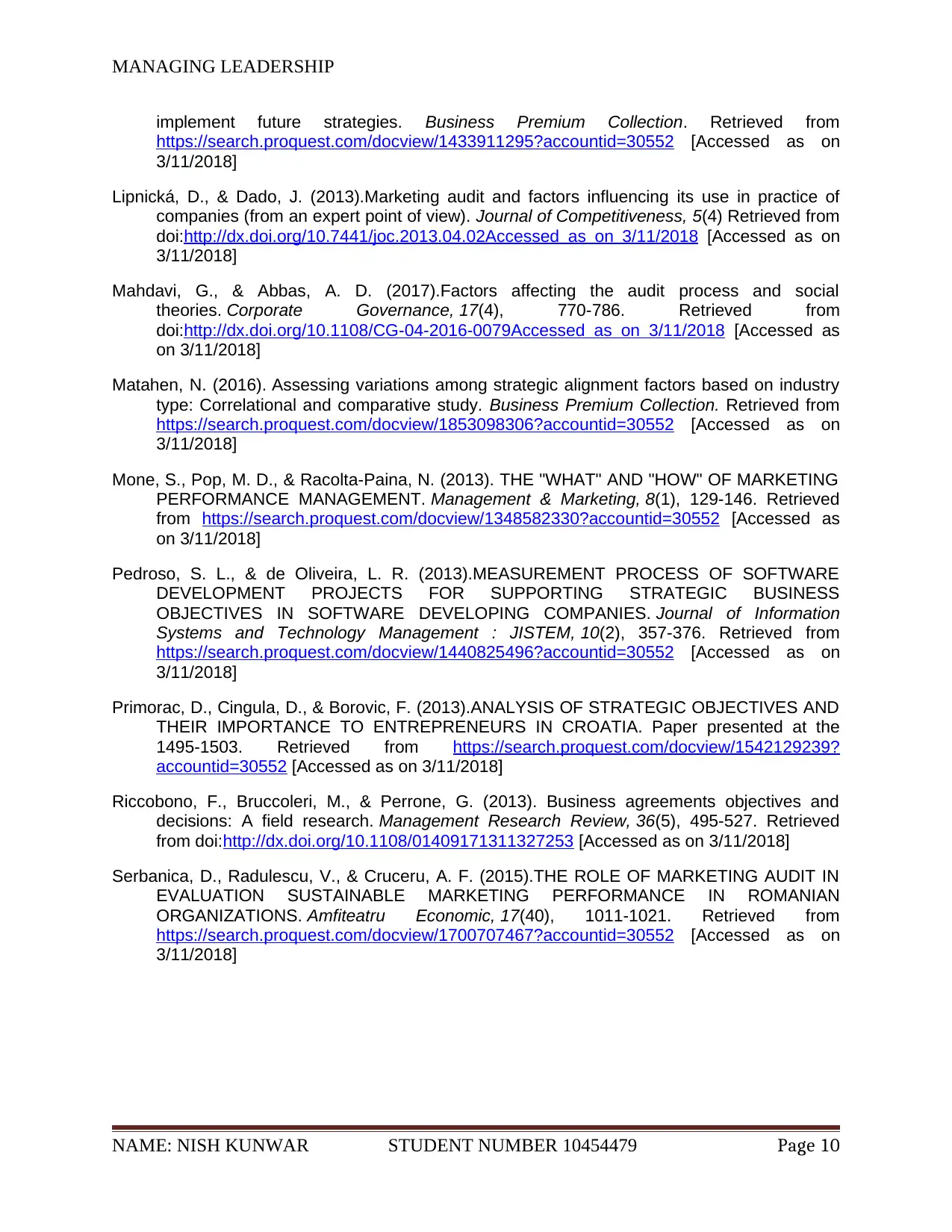
MANAGING LEADERSHIP
implement future strategies. Business Premium Collection. Retrieved from
https://search.proquest.com/docview/1433911295?accountid=30552 [Accessed as on
3/11/2018]
Lipnická, D., & Dado, J. (2013).Marketing audit and factors influencing its use in practice of
companies (from an expert point of view). Journal of Competitiveness, 5(4) Retrieved from
doi:http://dx.doi.org/10.7441/joc.2013.04.02Accessed as on 3/11/2018 [Accessed as on
3/11/2018]
Mahdavi, G., & Abbas, A. D. (2017).Factors affecting the audit process and social
theories. Corporate Governance, 17(4), 770-786. Retrieved from
doi:http://dx.doi.org/10.1108/CG-04-2016-0079Accessed as on 3/11/2018 [Accessed as
on 3/11/2018]
Matahen, N. (2016). Assessing variations among strategic alignment factors based on industry
type: Correlational and comparative study. Business Premium Collection. Retrieved from
https://search.proquest.com/docview/1853098306?accountid=30552 [Accessed as on
3/11/2018]
Mone, S., Pop, M. D., & Racolta-Paina, N. (2013). THE "WHAT" AND "HOW" OF MARKETING
PERFORMANCE MANAGEMENT. Management & Marketing, 8(1), 129-146. Retrieved
from https://search.proquest.com/docview/1348582330?accountid=30552 [Accessed as
on 3/11/2018]
Pedroso, S. L., & de Oliveira, L. R. (2013).MEASUREMENT PROCESS OF SOFTWARE
DEVELOPMENT PROJECTS FOR SUPPORTING STRATEGIC BUSINESS
OBJECTIVES IN SOFTWARE DEVELOPING COMPANIES. Journal of Information
Systems and Technology Management : JISTEM, 10(2), 357-376. Retrieved from
https://search.proquest.com/docview/1440825496?accountid=30552 [Accessed as on
3/11/2018]
Primorac, D., Cingula, D., & Borovic, F. (2013).ANALYSIS OF STRATEGIC OBJECTIVES AND
THEIR IMPORTANCE TO ENTREPRENEURS IN CROATIA. Paper presented at the
1495-1503. Retrieved from https://search.proquest.com/docview/1542129239?
accountid=30552 [Accessed as on 3/11/2018]
Riccobono, F., Bruccoleri, M., & Perrone, G. (2013). Business agreements objectives and
decisions: A field research. Management Research Review, 36(5), 495-527. Retrieved
from doi:http://dx.doi.org/10.1108/01409171311327253 [Accessed as on 3/11/2018]
Serbanica, D., Radulescu, V., & Cruceru, A. F. (2015).THE ROLE OF MARKETING AUDIT IN
EVALUATION SUSTAINABLE MARKETING PERFORMANCE IN ROMANIAN
ORGANIZATIONS. Amfiteatru Economic, 17(40), 1011-1021. Retrieved from
https://search.proquest.com/docview/1700707467?accountid=30552 [Accessed as on
3/11/2018]
NAME: NISH KUNWAR STUDENT NUMBER 10454479 Page 10
implement future strategies. Business Premium Collection. Retrieved from
https://search.proquest.com/docview/1433911295?accountid=30552 [Accessed as on
3/11/2018]
Lipnická, D., & Dado, J. (2013).Marketing audit and factors influencing its use in practice of
companies (from an expert point of view). Journal of Competitiveness, 5(4) Retrieved from
doi:http://dx.doi.org/10.7441/joc.2013.04.02Accessed as on 3/11/2018 [Accessed as on
3/11/2018]
Mahdavi, G., & Abbas, A. D. (2017).Factors affecting the audit process and social
theories. Corporate Governance, 17(4), 770-786. Retrieved from
doi:http://dx.doi.org/10.1108/CG-04-2016-0079Accessed as on 3/11/2018 [Accessed as
on 3/11/2018]
Matahen, N. (2016). Assessing variations among strategic alignment factors based on industry
type: Correlational and comparative study. Business Premium Collection. Retrieved from
https://search.proquest.com/docview/1853098306?accountid=30552 [Accessed as on
3/11/2018]
Mone, S., Pop, M. D., & Racolta-Paina, N. (2013). THE "WHAT" AND "HOW" OF MARKETING
PERFORMANCE MANAGEMENT. Management & Marketing, 8(1), 129-146. Retrieved
from https://search.proquest.com/docview/1348582330?accountid=30552 [Accessed as
on 3/11/2018]
Pedroso, S. L., & de Oliveira, L. R. (2013).MEASUREMENT PROCESS OF SOFTWARE
DEVELOPMENT PROJECTS FOR SUPPORTING STRATEGIC BUSINESS
OBJECTIVES IN SOFTWARE DEVELOPING COMPANIES. Journal of Information
Systems and Technology Management : JISTEM, 10(2), 357-376. Retrieved from
https://search.proquest.com/docview/1440825496?accountid=30552 [Accessed as on
3/11/2018]
Primorac, D., Cingula, D., & Borovic, F. (2013).ANALYSIS OF STRATEGIC OBJECTIVES AND
THEIR IMPORTANCE TO ENTREPRENEURS IN CROATIA. Paper presented at the
1495-1503. Retrieved from https://search.proquest.com/docview/1542129239?
accountid=30552 [Accessed as on 3/11/2018]
Riccobono, F., Bruccoleri, M., & Perrone, G. (2013). Business agreements objectives and
decisions: A field research. Management Research Review, 36(5), 495-527. Retrieved
from doi:http://dx.doi.org/10.1108/01409171311327253 [Accessed as on 3/11/2018]
Serbanica, D., Radulescu, V., & Cruceru, A. F. (2015).THE ROLE OF MARKETING AUDIT IN
EVALUATION SUSTAINABLE MARKETING PERFORMANCE IN ROMANIAN
ORGANIZATIONS. Amfiteatru Economic, 17(40), 1011-1021. Retrieved from
https://search.proquest.com/docview/1700707467?accountid=30552 [Accessed as on
3/11/2018]
NAME: NISH KUNWAR STUDENT NUMBER 10454479 Page 10
1 out of 10
Related Documents
Your All-in-One AI-Powered Toolkit for Academic Success.
+13062052269
info@desklib.com
Available 24*7 on WhatsApp / Email
![[object Object]](/_next/static/media/star-bottom.7253800d.svg)
Unlock your academic potential
© 2024 | Zucol Services PVT LTD | All rights reserved.





